#bone fragment holotypes be like
Explore tagged Tumblr posts
Text
Scientists will be like "new spinosauridae described last week!"
And the spino in question:

#paleontology#paleoblr#paleomedia#dinosaurs#spinosaurus#bone fragment holotypes be like#like it doesnt sounds right but i dont know enough about fossils to dispute this
8 notes
·
View notes
Text
It's National Dinosaur Day in Australia!
The 7th of May is officially National Dinosaur Day! While our fossil record might be a bit patchier than some continents, there are still plenty of excellent dinosaurs that have been found from the Mesozoic and Cenozoic, and here's a few of them!
Australovenator wintonensis

(art by Scott Reid)
Probably the most iconic Australian dinosaur, Australovenator was a large theropod with massive hooked hand claws from the Winton Formation. It was the first megaraptoran identified in Australia, a group of theropods that we now know were widespread and successful across the southern hemisphere in the Cretaceous!
Kunbarrasaurus ieversi


(art by Ashley Patch)
One of the few armoured dinosaurs found in Australia, Kunbarrasaurus ieversi is known from a beautiful full-body fossil from the Allaru Formation that preserves the armour plates in their life positions!
Dromornis stirtoni

(art by @knuppitalism-with-ue)
The Dromornithidae (also known as mihirungs) have a roughly emu-like body plan but are actually a member of the group Anseriformes, closer to waterfowl! Dromornis stirtoni from the Alcoota Fossil Beds is the largest bird to ever live in Australia that we know of, weighing around half a ton.
Genyornis newtoni
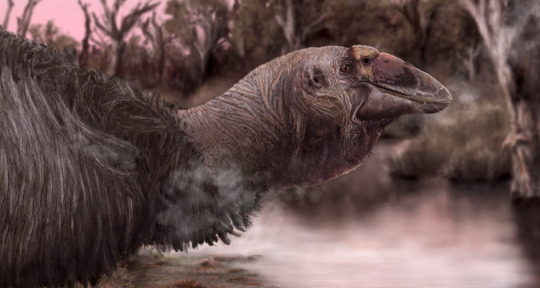
(art by Jacob Blokland)
The latest-surviving mihirung, Genyornis was described in 1896 but the first well-preserved skull fossil of this quarter-ton bird was only published last year by Phoebe McInerney, who I actually know! I also got to do a little bit of work on the second skull of Genyornis in the lab earlier this year so it's not only a cool animal but one I'm especially personally fond of!
Fostoria dhimbangunmal

(art by James Kuether)
Fostoria is a mid-sized iguanodontian that's known from Australia's only ornithischian bone bed, an extremely rare find for a continent whose Mesozoic dinosaur fossils tend to be pretty badly scattered and fragmented. The bones of multiple individuals were found together in the opal fields of the Griman Creek Formation, and the bones themselves had been opalised!
Australotitan cooperensis

(art by Vlad Konstantinov)
Known simply as Cooper for 15 years, Australotitan finally got a full description in 2021 which marked it out as not only Australia's biggest dinosaur but on the scale of some of the largest known sauropods in the world!
Anthropodyptes gilli

(art by,,, Travis Park? I think? this one was a Struggle)
Today the only penguin native to the mainland is the little blue penguin, but in prehistory there were much larger penguins around! They're only known from fragmentary remains in Australia, but species like Anthropodyptes gilli and Pachydyptes simpsoni grew larger than modern emperor penguins!
Diluvicursor pickeringi

(art by Peter Trusler)
One dinosaur we seem to have heaps of in Australia (as with the rest of the world) is small ornithischians. These sprinty little guys are almost ubiquitous in Mesozoic ecosystems, and in Australia Diluvicursor is one of the more complete examples, with a holotype fossil from the Eumeralla Formation that preserves the tail and foot bones.
Phoenicopteridae (Flamingos)
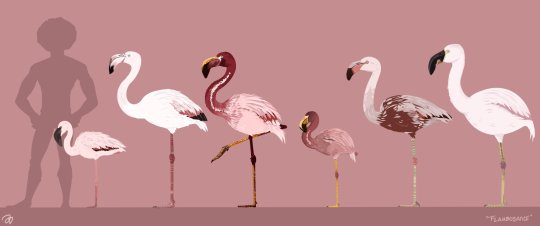
(art by Astrapionte, featuring from left to right: Phoeniconaias proeses, Phoenicopterus copei, Xenorhynchopsis tibialis and minor, Phoenicopterus novaehollandiae, and Phoeniconotius eyrensis)
Last fun fact about Australia, did you know we used to have flamingos until very recently? The flamingo fossil record in Australia is pretty limited, but we know they lived here from the Oligocene all the way to the Pleistocene, when they were likely wiped out by environmental change as the centre of the continent dried up. Phoeniconotius eyrensis seems to have been one of the largest flamingo species, likely heavier than the modern greater flamingo!
377 notes
·
View notes
Note
do you ever talk with germany about archaeology? i know he likes it too
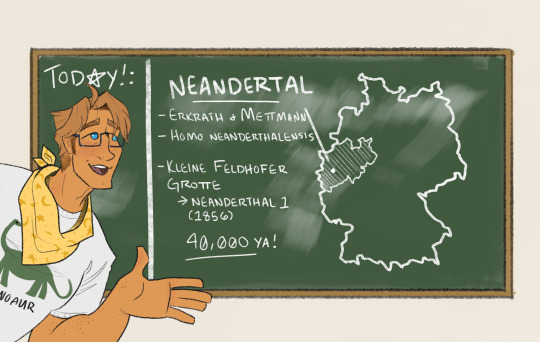
"Ludwig and I ain't talked about it in a while, but we did for a little bit! He tends to focus on Neolithic societies, but if there's one site we both have an interest in, it's Kleine Feldhofer Grotte in the Neandertal Valley. It's where the holotype fossil for Homo neanderthalensis, Neanderthal 1, was discovered in 1856! Ain't that amazing? It was part of the beginnings of paleoanthropology! Of it was found a full skull cap, for one, but also two femora, the right arm bones, two of the left arm bones, and fragments of the individual's scapulae and ribs. Gosh, dude, I could probably talk about this fossil as much as I could about 'Lucy'!
"Man, I don't know how to say how excited I'd be if I ever got the signal from Ludwig that we could go do a visit to some of his sites! An' I also haven't seen the guy in a long while - he keeps himself busy. I should text him, I swear! I'm sorry he couldn't join the ask today. Hopefully someday we get some guests on here, guys!"
#ask archaeology boy#archaeology f jones#hetalia#hetalia ask blog#aph america#hws america#alfred f jones
36 notes
·
View notes
Note
Inscryption is a roguelike deck-building game developed by Daniel Mullins Games and published by Devolver Digital. Inscryption was released for Microsoft Windows on October 19, 2021. It was released on Linux and MacOS on June 22, 2022. Versions for PlayStation 4 and PlayStation 5 were released in August 2022.
Mononykus (/məˈnɒnɪkəs/ mə-NON-ik-əs, sometimes /ˌmɒnoʊˈnaɪkəs/ MON-oh-NY-kəs; meaning "one claw") is a genus of alvarezsaurid dinosaur that lived during the Late Cretaceous in what is now Asia on the Nemegt Formation, about 70 million years ago. Mononykus was a very small theropod, estimated around 1 to 1.2 metres (3.3 to 3.9 ft) in length with a weight of 3.5 kilograms (7.7 lb). As in Shuvuuia, Mononykus likely developed a shaggy feathering. It was lightly built with long, thin legs and highly reduced and specialized forelimbs that were likely used for foraging termite mounds or other insect colonies. Mononykus is represented by a single holotype specimen, catalog number MPC-D 107/6 (formerly IGM 107/6). It was collected in 1987 from the Bügiin Tsav locality of the Nemegt Formation, Gobi Desert. This specimen consists of a partial skeleton lacking a tail, and only small fragments of skull bones, including a complete braincase.[1][2] Mononykus was originally named Mononychus in 1993, but later that year, it was renamed because the original name had already been used for a beetle named by Johann Schueppel, a German entomologist.[3] Several other specimens were later misclassified as Mononykus, including specimens with partial tails (initially misinterpreted as being very short, though later specimens showed they were long and thin) and complete skulls showing a distinct, mostly toothless form.[4] However, these specimens have since been reclassified in the new genus Shuvuuia.[5] Because of this, many reconstructions of Mononykus in art and mounted skeletons in museums are in fact based mainly on Shu
6 notes
·
View notes
Text
Early Bats: Ancient Origins of a Halloween Icon
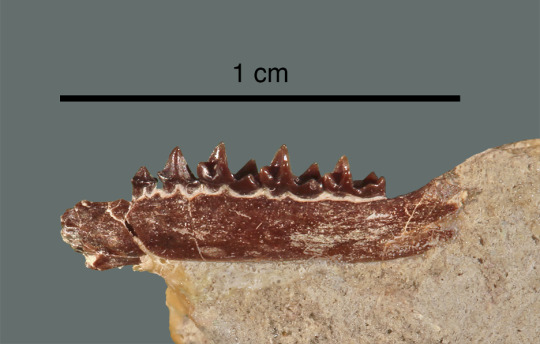
Specimen Carnegie Museum (CM) 62641, the holotypic, or name-bearing, right dentary (lower jaw bone) of the tiny fossil bat Honrovits tsuwape in lingual (= internal) view, still partially encased in ~50-million-year-old rock of the Wind River Formation of west-central Wyoming. Note the length of the scale bar, only 1 cm (less than half an inch)!
Did you know that bats have been around for at least 55 million years? In 1992, several fossils in the Carnegie Museum of Natural History collection, including the lower jaw bone shown above, were described as representing a new genus and species of ancient bat, Honrovits tsuwape—Shoshone for “bat” and “ghost,” respectively—by a team that included two former curators in the museum’s Section of Vertebrate Paleontology, Christopher Beard and Leonard Krishtalka, both now of the University of Kansas. Honrovits dates to the early part of the Eocene Epoch of the Cenozoic Era (the ‘Age of Mammals’), about 50 million years ago, and is a member of a now-extinct bat group called the Onychonycteridae.
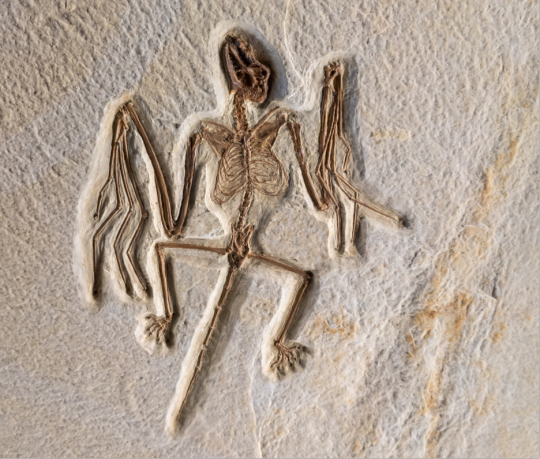
Replica of a beautifully preserved fossil skeleton of Onychonycteris finneyi, a close relative of Carnegie Museum of Natural History’s own Eocene-aged bat Honrovits tsuwape, on display at Fossil Butte National Monument in Wyoming. Photo by Matthew Dillon.
Interestingly, Honrovits shares dental characteristics with a mammal group known as insectivores, which includes today’s hedgehogs, shrews, and moles, and in that sense, it differs from the condition in most other bats. However, bat teeth possess distinctive diagnostic features, so although Honrovits is known only from a few tooth-bearing jaw bones and a skull fragment, there’s no doubt that the diminutive beast was indeed an early bat. The fragmentary nature of its fossils means that we don’t know for sure what Honrovits looked like in life, though it’s a good bet that it bore a close resemblance to other onychonycterid bats, such as Onychonycteris finneyi, which is known from exquisitely preserved skeletons (such as the one shown above).
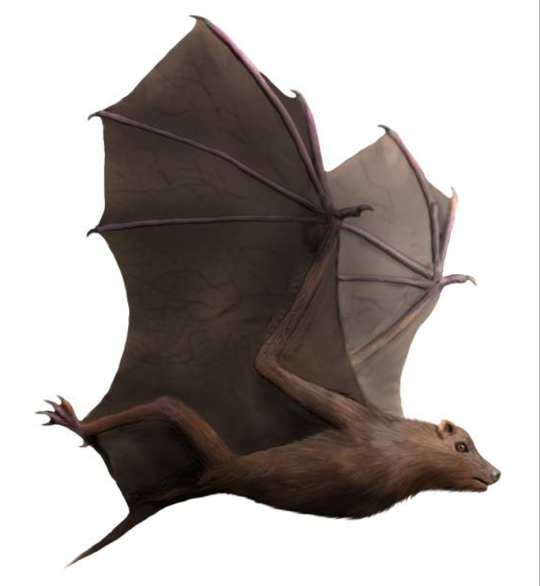
Flesh reconstruction of the ~50-million-year-old bat Onychonycteris finneyi. There’s an excellent chance that Honrovits tsuwape would have looked like this. Art by Nobu Tamura.
The incompleteness of the Honrovits fossils is, unfortunately, the norm rather than the exception when it comes to prehistoric bats. Fossils of these creatures are exceedingly rare because most bats have very small, light skeletons and achieve their greatest diversity and abundance in areas that have low potential for fossil preservation, such as tropical forests. Occasionally, complete skeletons such as those of Onychonycteris are found, but not nearly as often as fragments.
So, this autumn, if you happen to catch a glimpse of a bat silhouetted against the evening sky, acrobatically wheeling and plunging in pursuit of flying insects, pause and reflect on the history of these extraordinary flying mammals whose ancestry dates nearly to the time of the dinosaurs.
Linsly Church is a Curatorial Assistant in the Section of Vertebrate Paleontology at Carnegie Museum of Natural History. Museum staff, volunteers, and interns are encouraged to blog about their unique experiences and knowledge gained from working at the museum.
#Carnegie Museum of Natural History#Bat fossil#Fossils#Paleonotlogy#Halloween#Honrovits tsuwape#Onychontcteris finneyi
133 notes
·
View notes
Photo
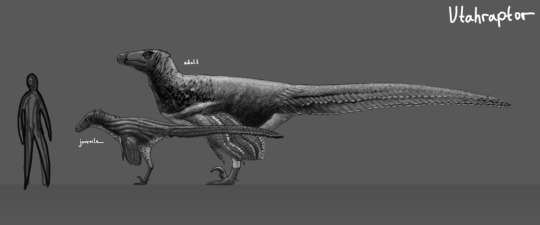
Utahraptor Project by Hyrotrioskjan
I remember that I saw years ago a documentary about the dinosaurs of Utah, in one scene James Kirkland was climbing a cliff to get to some researches who investigated some Utahraptor bones. That got me already excited because I knew how little material of Utahraptor we actually had. 2 years ago I heard again of this find, thanks to Facebook I learned that the few bones turned out to be a 9 ton heavy block mostly made of bone, containing a whole flock of Utahraptors in different ontogenetic stages. I waited eagerly until the block was removed and every little bit I hear and see about it makes me happy. Unfortunately money and equipment are lacking to finally bring this bunch of wonderfully weird, and giant dromaeosaurs back to light. That's why they started a Go-Fund-Me campaign, to bring the financial power to the forefront of science where it is deserved. I can't stretch how awesome but frustrating it is to know that there is a huge block full of all the stuff I always wondered about my once favorite dinosaur and that the people who want to uncover these secrets too can't because governmental funding doesn't cover it. I recently donated to the campaign and because I'm not able to give much I thought I should at least try to make more people aware of this project. The two animals you see here are still very speculative, based on a few fragments which are already recovered and the holotype material. I hope this picture will change and sharpen over time, it is just a little glimpse at the possibilities which might lurk within that old quicksand trap. If you are interested in the progress as well, and have a little bit of spare money I recommend you their site https://www.gofundme.com/utahraptor Edit: On a side note, this is one of my few completely digital works, I felt like I needed to train a little bit more in this field.
17 notes
·
View notes
Text
The Bromacker Fossil Project Part VIII: Martensius bromackerensis, Honoring a colleague
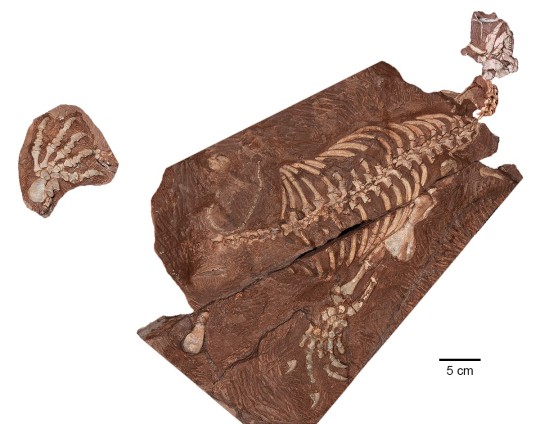
Adult, holotype specimen of Martensius bromackerensis. Image digitally assembled by the author from five photographs taken by Diane Scott (Preparator at University of Toronto Mississauga [UTM]), 2010–2013. The specimen was collected in several large blocks.
The formal publication of some of the Bromacker discoveries took more time to complete than others, and our most recently pubished fossil, Martensius bromackerensis, holds the record in that regard. Four nearly complete specimens of Martensius were collected from the Bromacker quarry between 1995–2006. The first, discovered by Thomas Martens and his father Max, came from a jumbled pocket of fossils. Unfortunately, muddy groundwater had penetrated cracks in the subsurface of this portion of the quarry and coated and eroded bone present along these cracks. Despite this damage and the lack of a skull, we could identify the specimen as a caseid synapsid (synapsids, also known as mammal-like reptiles, are a group of amniotes whose later-occurring members gave rise to mammals).
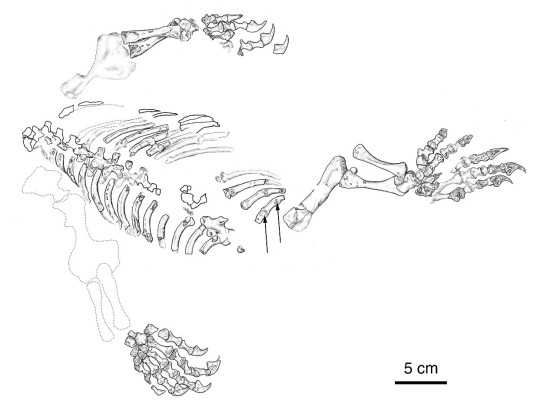
Drawing of 1995 Martensius bromackerensis specimen. Because the specimen was collected in numerous pieces of rock, with parts of some bones exposed on apposing rocks, Scientific Illustrator Kevin Dupuis (UTM) had to first draw the bones exposed on each piece and then assemble all of the drawings digitally. Dotted lines indicate bone impression in the rock. Arrows point to healing scars from two fractures in the last right rib. Additional healing scars can be seen in preceding ribs. This animal apparently survived a serious injury. Modified from Berman et al., 2020.
The next specimen was discovered in 1999 by Georg Sommers (Preparator, Museum der Natur, Gotha), who prepared the fossil. It consists of a vertebral column, ribs, some limb bones, and a few scattered skull elements. Unfortunately, a more complete skull was needed to allow for comparison to other caseids, some of which are based only on skull material. It wasn’t until the discovery of two more specimens in 2004 and 2006 by Stuart Sumida and Dave Berman, respectively, that the long sought-after skull was found. Preparation of these specimens took a long time due to their size and the considerable amount of rock covering the bones in some of the blocks. My promotion to Collection Manager in 2005 left me with considerably less time to prepare fossils. Other preparators were asked to help with the preparation at both Carnegie Museum of Natural History (CMNH, Dan Pickering and Tyler Schlotterbeck) and in Dr. Robert Reisz’s lab at the University of Toronto at Mississauga (Diane Scott and Nicola Wong Ken). Robert was originally slated to lead the study, but other commitments prevented him from working on it, so Dave took over.
Besides preparation, the scientific study and publication of the specimens required illustrations and photographs, most of which were done by Diane, Nicola, and Kevin. Andrew McAfee (Scientific Illustrator, CMNH) made skeletal and flesh reconstructions of the animal, as well as an illustration of two Martensius in their ancient habitat (see The Bromacker Fossil Project Part III for a link to this illustration). All of this effort was worth it, however, because besides adding to the diversity of the Bromacker vertebrate fauna, Martensius has an unusual life history.

Juvenile specimen of Martensius bromackerensis. Image digitally assembled by the author from two photographs (skull and body) taken by Diane Scott in 2013. The skull, shown in ventral aspect, is incomplete and eroded on its dorsal surface.
Caseid synapsids are a diverse, long-lived group known from the Late Pennsylvanian–Middle Permian epochs (~300–259 million years ago) of Europe, Russia, and the USA, and, with one exception, all are adapted to eating plants (herbivorous). The most advanced caseids (such as the enormous Cotylorhynchus romeri) have ridiculously small skulls when compared to those of carnivores, spatulate (spoon-shaped) teeth tipped with small tubercles (cuspules) for cropping vegetation, and huge, barrel-shaped ribcages to support a large gut for fermenting cellulose-rich plants. The exception is the earliest known (Late Pennsylvanian epoch, ~300 million years ago) caseid, Eocasea martini, represented by a single, incomplete juvenile specimen from Kansas. The teeth of Eocasea are small and conical, which indicate that it most likely ate insects. Because it’s skull and ribcage are of normal size, in contrast to juveniles of Martenius, Eocasea probably ate insects throughout its life.

Reconstruction of the skull of Martensius bromackerensis (left) from the Early Permian (~290 million years ago) Bromacker quarry, Germany, and the more advanced caseid Ennatosaurus tecton (skull, middle and skull fragment with cuspule-tipped teeth, right), from the Middle Permian (~263 million years ago) of Russia. Skull reconstruction of Martensius made by Diane Scott and modified from Berman et al., 2020. Ennatosaurus skull reconstruction and jaw fragment drawing modified from Maddin et al., 2008.
Martensius has a modestly expanded ribcage and a small skull, suggesting that it was herbivorous. Furthermore, the feet of Martensius, like those of other caseids in which the feet are known, are large, with massive, elongated, strongly recurved claws. Martensius also has a well-supported hip region that may have enabled it to rise on its hind legs to reach and tear down overhead branches to feed upon.
The upper and lower teeth of the adult Martensius differ from those of more advanced caseids in being triangular and lacking cuspules. The upper jaw teeth of the juvenile resemble those of the adult, but the lower jaw teeth are more numerous—31 in the juvenile compared to 25 in the adult—and surprisingly, they resemble those of Eocasea. Dave concluded that juveniles of Martensius had teeth adapted for eating insects, which were replaced by an adult dentition that would’ve been good for cropping plants and piercing insects. Remarkably, the juvenile Martensius apparently died while in the process of replacing its juvenile dentition with that of adults.
So why have different juvenile and adult dentitions? Modern animals that eat fibrous plant matter have micro-organisms called fermentative endosymbionts in their large guts, which break down difficult-to-digest plant matter via fermentation. It is assumed that early fossil plant-eaters with broad ribcages also had large guts housing fermentative endosymbionts. Prior to the discovery of Martensius, other scientists hypothesized that early herbivores acquired endosymbionts by eating herbivorous insects that already had these microbes in their guts. In Martensius, the introduction of endosymbionts apparently occurred during the juvenile, insectivorous stage of life, which set the stage for adults to add plants to their diet.

Flesh (top) and skeletal (bottom) reconstructions of Martensius bromackerensis. Illustrations by Andrew McAfee and modified from Berman et al., 2020.
The generic name Martensius honors Thomas Martens for his discovery of vertebrate fossils at the Bromacker quarry and his perseverance in maintaining a highly successful, long-term field operation resulting in the discovery and publication of the exceptionally preserved Bromacker fossils. Bromackerensis refers to the Bromacker quarry, the only locality from which this species is known.
Stay tuned for my next post, which will feature some terrestrial dissorophoid amphibians.
For those of you who would like to learn more about Martensius, here’s a link to the 2020 Annals of Carnegie Museum publication in which it was described: https://www.researchgate.net/publication/340309382_New_Primitive_Caseid_Synapsida_Caseasauria_from_the_Early_Permian_of_Germany
Amy Henrici is Collection Manager in the Section of Vertebrate Paleontology at Carnegie Museum of Natural History. Museum employees are encouraged to blog about their unique experiences and knowledge gained from working at the museum.
#Carnegie Museum of Natural History#Paleontology#Vertebrate Paleontology#Fossils#Bromacker Quarry#Bromacker Fossil Project#Martensius bromackerensis
77 notes
·
View notes